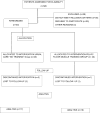A pilot randomized control trial to evaluate pelvic floor muscle training for urinary incontinence among gynecologic cancer survivors
- PMID: 24183730
- PMCID: PMC5399541
- DOI: 10.1016/j.ygyno.2013.10.024
A pilot randomized control trial to evaluate pelvic floor muscle training for urinary incontinence among gynecologic cancer survivors
Abstract
Objectives: We previously reported high rates of urinary incontinence among gynecologic cancer survivors and aimed to evaluate the effectiveness of a simple intervention for treatment of urinary incontinence in this population.
Methods: We recruited 40 gynecologic cancer survivors who reported urinary incontinence on a validated questionnaire. Women were randomized to either pelvic floor muscle training/behavioral therapy (treatment group) or usual care (control group). The primary outcome measure, assessed at 12 weeks post intervention, was a 40% difference in the validated Patient Global Impression of Improvement (PGI-I) score. Fisher's exact test was used to identify differences between groups for frequency data; two-sample t-test was conducted for continuous measurements.
Results: Mean age of this cohort was 57 (range: 37-79). The majority of the survivors had uterine cancer (60%), 18% had received radiation therapy, 95% had received surgical therapy, and 35% had received chemotherapy. At three months, 80% of the treatment and 40% of the control group reported that their urinary incontinence was "much better" or "very much better" as evaluated by the Patient Global Impression of Improvement scale (p=0.02). Brink's scores were significantly improved in the treatment group as compared to those of the controls (p<0.0001). Treatment group adherence was high; the treatment group performed exercises with an average of 22 days/month.
Conclusions: Urinary incontinence negatively affects quality of life, and despite a high prevalence among gynecologic cancer survivors, it is often under-assessed and undertreated. We found a simple intervention that included pelvic floor muscle training and behavioral therapy, which significantly improved cancer survivor's urinary incontinence.
Keywords: Cancer survivorship; Quality of life; Urinary incontinence.
© 2013.
Conflict of interest statement
The authors declare that there are no conflicts of interest.
Figures
Similar articles
-
Evaluation of the effect of pelvic floor muscle training (PFMT or Kegel exercise) and assisted pelvic floor muscle training (APFMT) by a resistance device (Kegelmaster device) on the urinary incontinence in women: a randomized trial.Eur J Obstet Gynecol Reprod Biol. 2011 Nov;159(1):218-23. doi: 10.1016/j.ejogrb.2011.06.037. Epub 2011 Jul 7. Eur J Obstet Gynecol Reprod Biol. 2011. PMID: 21741151 Clinical Trial.
-
A pilot randomized trial of conventional versus advanced pelvic floor exercises to treat urinary incontinence after radical prostatectomy: a study protocol.BMC Urol. 2015 Sep 16;15:94. doi: 10.1186/s12894-015-0088-4. BMC Urol. 2015. PMID: 26377550 Free PMC article. Clinical Trial.
-
Effect of vaginal spheres and pelvic floor muscle training in women with urinary incontinence: a randomized, controlled trial.Neurourol Urodyn. 2015 Aug;34(6):533-8. doi: 10.1002/nau.22640. Epub 2014 Aug 17. Neurourol Urodyn. 2015. PMID: 25130167 Clinical Trial.
-
Pelvic floor dysfunction in gynecologic cancer survivors.Eur J Obstet Gynecol Reprod Biol. 2023 Sep;288:108-113. doi: 10.1016/j.ejogrb.2023.07.010. Epub 2023 Jul 24. Eur J Obstet Gynecol Reprod Biol. 2023. PMID: 37499277 Review.
-
The pelvic floor muscles: muscle thickness in healthy and urinary-incontinent women measured by perineal ultrasonography with reference to the effect of pelvic floor training. Estrogen receptor studies.Neurourol Urodyn. 1997;16(4):237-75. doi: 10.1002/(sici)1520-6777(1997)16:4<237::aid-nau2>3.0.co;2-f. Neurourol Urodyn. 1997. PMID: 9220475 Review.
Cited by
-
Experiences of incontinence and pelvic floor muscle training after gynaecologic cancer treatment.Support Care Cancer. 2017 Jan;25(1):157-166. doi: 10.1007/s00520-016-3394-9. Epub 2016 Sep 5. Support Care Cancer. 2017. PMID: 27596267 Free PMC article.
-
Educational telerehabilitation program for women with pelvic floor dysfunctions after gynecological pelvic cancer treatment: protocol study for a randomized and controlled clinical trial.Trials. 2024 May 28;25(1):347. doi: 10.1186/s13063-024-08138-1. Trials. 2024. PMID: 38802934 Free PMC article.
-
Pre-rehabilitation of the pelvic floor before radiation therapy for cervical cancer: a pilot study.Int Urogynecol J. 2020 Nov;31(11):2411-2418. doi: 10.1007/s00192-020-04391-5. Epub 2020 Jun 29. Int Urogynecol J. 2020. PMID: 32601784
-
Pelvic Floor Therapy and Initial Interventions for Pelvic Floor Dysfunction in Gynecologic Malignancies.Curr Oncol Rep. 2024 Mar;26(3):212-220. doi: 10.1007/s11912-024-01498-6. Epub 2024 Jan 31. Curr Oncol Rep. 2024. PMID: 38294706 Review.
-
Effects of radiation therapy on the structure and function of the pelvic floor muscles of patients with cancer in the pelvic area: a systematic review.J Cancer Surviv. 2016 Apr;10(2):351-62. doi: 10.1007/s11764-015-0481-8. Epub 2015 Aug 28. J Cancer Surviv. 2016. PMID: 26314412
References
-
- Ries L, Harkins D, Krapcho M, Mariotto A, Miller B, Feuer E, et al. SEER Cancer Statistics Review, 1975–2004. Bethesda: National Cancer Institute; 2007. [cited 2007]; Available from: http://seer.cancer.gov/csr/1975_2004/
-
- Fantl JA, Newman D, Colling J, DeLancey J, Keeys C, Loughery R, et al. In: Urinary incontinence in adults: acute and chronic management. 2nd. Department of Health and Human Services PHS, editor. 1996.
-
- Kegel AH. Progressive resistance exercise in the functional restoration of the perineal muscles. Am J Obstet Gynecol. 1948;56(2):238–48. Epub 1948/08/01. - PubMed
-
- Kegel AH. Physiologic therapy for urinary stress incontinence. JAMA. 1951;146(10):915–7. Epub 1951/07/07. - PubMed
Publication types
MeSH terms
Grants and funding
LinkOut - more resources
Full Text Sources
Other Literature Sources
Medical



